This website is supported by its readers. If you click one of my links I may earn a commission. I am also a participant in the Amazon affiliates program and I will also earn a commission from qualified purchases.
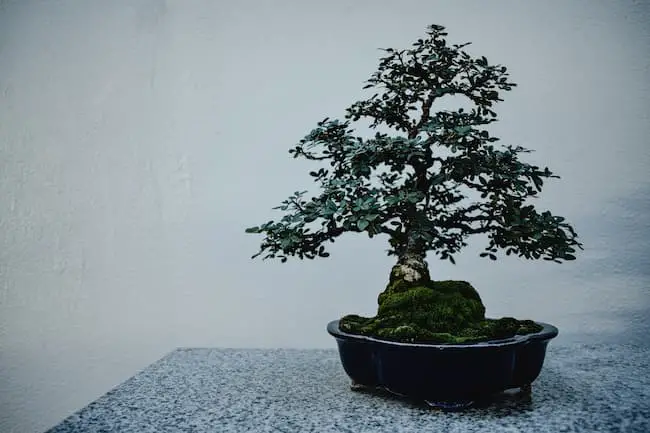
Over the past few years, I’ve spent a lot of time getting to groups with the basics of bonsai tree. As such, I’ve spent a lot of time training beginner-friendly bonsai, such as the Chinese elm and Ficus varieties. With a few years under my belt, I’m now looking to move on to slightly harder care for trees. Naturally, this got me asking, what are the hardest bonsai trees to grow?
The hardest bonsai trees to grow are:
- Scots Pine (Pinus sylvestris)
- Cherry Blossom (Prunus serrulata)
- Jasmin (Gardenia jasminoides)
- Hickory (Carya)
- Buttonwood (Conocarpus erectus)
- Bamboo (Bambusa)
- Cedarwood (Cedrus)
Other trees with large or unusually shaped leaves, such as Palm, Rosemary, or Manzanita, can also be challenging to turn into bonsai.
Just a quick heads up, over the past three years of running Plantpaladin, hundreds of people have asked for product recommendations. As such, You can find my favorite indoor bonsai tree here (link takes you to Bonsaiboy), my favorite outdoor bonsai tree (link takes you to Bonsaiboy), or have a look at all the products I recommend here.
What are the hardest bonsai trees to grow?
I started experimenting with some tree species above to determine the most complex bonsai trees grow.
I also consulted several bonsai experts and visited my local botanical gardens.
Finally, I surveyed 20 Plant Paladin readers about the hardest bonsai trees to grow.
To summarize;
- Scots Pine, Cherry Blossom, Jasmin, Hickory, Buttonwood, Bamboo, and Cedarwood trees are the most complicated bonsai trees to grow.
- While they can all be transformed into bonsai trees, they can be challenging to grow due to their watering, sunlight, and temperature sensitivity.
- Many of these trees are also hard to grow due to being hard to train and shape into miniature trees and frequent pruning required to keep on top of them.
- While these trees are challenging to grow, each makes for excellent bonsai trees.
- Easy-to-train bonsai trees include Chinese Elm, Jade, Ficus, and Fukien Tea varieties.
- While it is a common bonsai tree, Juniper bonsai trees can also be challenging to grow.
- Most outdoor bonsai trees will also be more challenging to grow than indoor varieties due to space requirements and the demand these trees take on surrounding soil.
- In terms of bonsai tree styles, creating a bonsai tree in the literati or multiple-trunk style will be the most challenging.
This is a lot of information to break down, so let’s start by discussing why some tree species are so hard to grow.

Scots Pine (Pinus Sylvestris)
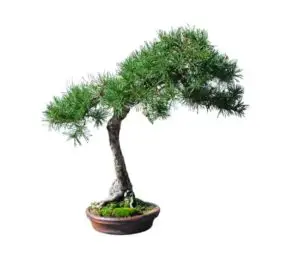
So first up on the challenging bonsai tree list are Scots Pine bonsai trees.
These trees make for fantastic outdoor bonsai; however, they can be incredibly challenging to grow for a few reasons.
These trees are costly, pricing many people out of actually purchasing these trees.
Why are Scots Pine bonsai trees hard to grow?
- Environmental Requirements: Scots Pine is a species native to colder regions, requiring a cold winter dormancy period to thrive. Maintaining the right temperature conditions can be difficult in some climates, especially if you live in a warm or tropical area. The tree may need the necessary winter dormancy to grow correctly or even die.
- Long Development Time: Scots Pine bonsai trees have a slow growth rate and take a long time to develop the desired bonsai characteristics. Training a Scots Pine into a mature and aesthetically pleasing bonsai can take several years, even decades. This requires patience, consistent care, and regular pruning and shaping.
- Maintenance and Styling: Scots pine bonsai trees require regular maintenance and careful styling to achieve the desired bonsai aesthetics. Pruning and wiring techniques must be applied correctly to maintain the shape and size of the tree. This can be challenging, especially for beginners, as incorrect pruning or wiring techniques can harm the tree’s health and appearance.
- Pests and Diseases: Scots pine bonsai trees can be susceptible to various pests and diseases, including aphids, spider mites, and fungal infections. Managing these issues requires vigilance, regular inspection, and appropriate treatment if necessary.
Cherry Blossom (Prunus Serrulata)
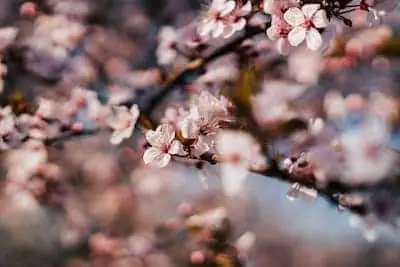
If you were to ask me what my favorite-looking bonsai tree is, Cherry blossom.
These beautiful bonsai trees, when they blossom, are an absolute marvel to see.
These looks often come with many challenges, meaning that these secure trees can be difficult to grow.
Why are Cherry blossom bonsai trees hard to grow?
- Specific Climate Requirements: Cherry blossom trees have specific climate requirements. They are native to temperate regions with distinct seasonal changes. These trees require winter dormancy and a cool period to promote healthy growth and flower bud development. It can be challenging to meet these specific needs in warmer climates or regions without sufficient temperature fluctuations.
- Flowering Challenges: With cherry blossom bonsai, achieving consistent and abundant flowering can be challenging. These trees require a delicate balance of light, temperature, and nutrient levels to produce beautiful blossoms. Factors such as insufficient light, incorrect pruning techniques, or imbalanced fertilization can affect flowering and result in little or no blossoms.
- Pruning and Maintenance: Pruning cherry blossom bonsai trees can be tricky. They tend to thrive, and improper pruning can lead to weak growth or inhibit flowering. Careful and precise pruning techniques are necessary to maintain the desired shape and encourage healthy growth and flowering.
- Vulnerability to Pests and Diseases: Cherry blossom bonsai trees can be susceptible to various pests and diseases, such as aphids, scale insects, fungal infections, and cherry blossom blight. Maintaining proper hygiene, regularly inspecting the tree for signs of pests or diseases, and taking appropriate preventive measures are crucial to protect the tree’s health.
- Longevity Challenges: Cherry blossom trees have relatively short lifespans than other bonsai species. While they can live for several decades, they are more prone to disease and decline as they age. This can require extra vigilance and care to ensure the tree remains healthy and attractive over the long term.
Jasmin (Gardenia jasminoides)
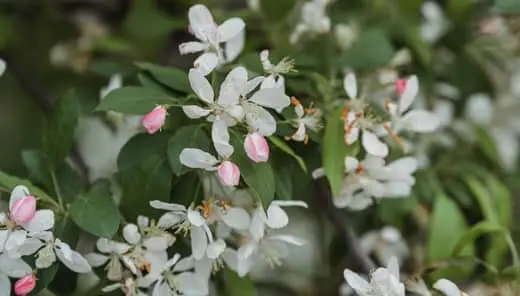
One of the best things about Jasmin bonsai trees is just the bright white flowers that come along with the tree.
That said, flowering bonsai trees are tricky to grow at the best of times, let alone Jasmin bonsai trees which are amongst the most challenging.
Why are Jasmin bonsai trees hard to grow?
- Specific Environmental Requirements: Jasmine bonsai trees, particularly species like Jasminum sambac (Arabian jasmine), have specific environmental requirements that can be difficult to replicate in all climates. They thrive in warm and tropical regions with high humidity. Providing the right temperature, humidity, and light conditions can be challenging in regions with colder or drier climates.
- Pruning and Training: Jasmine bonsai trees require regular pruning and training to maintain their desired shape and size. They tend to have vigorous growth, and without proper pruning, they can become leggy and lose their bonsai aesthetics. Pruning must be done carefully to encourage compact growth and promote the formation of new branches and flowers.
- Flowering Challenges: Jasmine bonsai trees are prized for their fragrant flowers. However, achieving consistent and abundant flowering can be challenging. Factors such as insufficient light, incorrect pruning, inadequate nutrition, or improper watering can affect flowering. Jasminum sambac, for example, tends to flower best when it receives adequate sunlight and warm temperatures, which may be challenging to provide in certain climates.
- Watering and Soil Requirements: Jasmine bonsai trees have specific watering and soil requirements. They prefer well-draining soil that retains some moisture but does not become waterlogged. Overwatering or underwatering can lead to root rot or other problems. Striking the right balance of moisture can be challenging, especially for beginners.
Hickory (Carya)
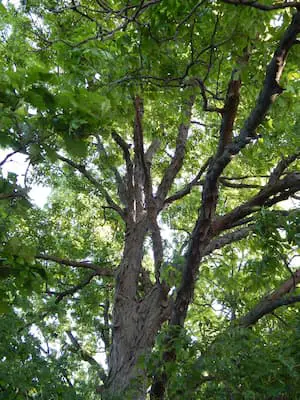
Hickory bonsai trees, if grown correctly, can accurately represent a miniature tree with beautiful sprawling branches and a long thin trunk.
That said, Hickory bonsai trees are notorious for having large taproots, big leaves, and hard, inflexible wood, making it challenging to train.
Why are hickory bonsai trees hard to grow?
- Hardwood: Hickory trees, known for their solid and dense hardwood, can make shaping and styling them into bonsai challenging. The hardness of the wood makes it difficult to achieve the desired bends, twists, and delicate shaping that are often sought after in bonsai. Working with tough hickory wood may require Specialized tools and techniques.
- Large Taproot: Hickory trees typically develop a taproot, a long, thick main root that grows deep into the ground. Taproots can make creating a shallow root system necessary for bonsai cultivation challenging. The taproot may need to be pruned or redirected during the early stages of training, which can be a delicate and time-consuming process.
- Big Leaves: Another challenge with hickory bonsai trees is their relatively large leaves. Bonsai aesthetics often favor smaller leaves to maintain proportion and balance in the miniature tree. However, hickory trees naturally have larger leaves, which can take away from the desired aesthetic of a bonsai. Techniques such as leaf pruning or defoliation may be necessary to reduce leaf size and improve the overall appearance.
- Slow Growth: Hickory trees have a relatively slow growth rate, so training and developing a hickory bonsai can take longer compared to some other tree species. Patience and long-term commitment are necessary to achieve the desired bonsai characteristics, as it can take several years or even decades to create a mature and aesthetically pleasing hickory bonsai.
Buttonwood (Conocarpus erectus)
Buttonwood bonsai trees are excellent mainly because of their rough bark and branches.
These trees then are notorious for having natural nebari and Jin, which adds character to bonsai trees.
That said, maintenance can be incredibly difficult for this tree.
What are buttonwood bonsai trees hard to grow?
- Slow Growth: Buttonwood bonsai trees have a relatively slow growth rate, so developing the desired bonsai aesthetics takes longer. This requires patience and long-term commitment, as training a buttonwood bonsai into a mature and well-shaped tree can take several years or even decades.
- Pruning and Wiring Difficulties: Buttonwood trees have hard, dense wood, making them challenging to prune and wire. The branches can be stiff and resistant to shaping, requiring special tools and techniques to achieve desired bends and curves. Inexperienced or improper pruning and wiring can harm the tree’s health and hinder its overall appearance.
- Salt Tolerance: Buttonwood is a coastal species that naturally grow in areas with high salt content, such as along shorelines. This means that buttonwood bonsai trees require a certain level of salt tolerance in their care. Providing the correct salt balance in the soil and water can be challenging, mainly if you live in an area with low salt content.
- Watering and Humidity Needs: Buttonwood bonsai trees prefer a consistently moist environment but are susceptible to root rot if kept overly wet. Achieving the proper soil moisture balance can take time and effort. Additionally, buttonwood bonsai trees thrive in high-humidity conditions, which may be difficult to replicate in certain climates or indoor settings.
- Pests and Diseases: Buttonwood bonsai trees can be prone to various pests and diseases, including fungal infections, scale insects, and mealybugs. Regular monitoring and preventive measures are necessary to protect the tree from infestations or diseases that can harm its health and growth.
Bamboo (Bambusa)
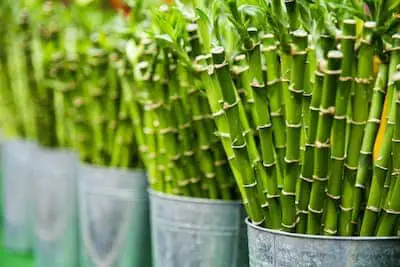
So bamboo bonsai trees are most definitely advanced bonsai trees.
This is because the thin stalk-like trunks make it challenging to create a thick trunk, so these trees are often used to create bonsai forests.
On top of this, these trees grow incredibly quickly, meaning a lot of maintenance will be needed.
What are bamboo bonsai trees hard to grow?
- Growth Characteristics: Bamboo is known for its rapid growth and vigorous spreading nature. This growth habit can make maintaining a bonsai tree’s desired size and shape challenging. Regular and meticulous pruning is necessary to control its growth and prevent it from becoming unmanageable.
- Rhizome Management: Bamboo spreads through underground rhizomes, making it difficult to contain in a bonsai pot. Rhizomes can quickly fill the pot and may require regular root pruning to prevent the tree from becoming root-bound. Failure to manage the rhizomes can lead to a loss of bonsai aesthetics and cause the tree to become weak or unhealthy.
- Watering and Moisture Requirements: Bamboo bonsai trees have specific watering needs. They prefer consistently moist soil but are susceptible to root rot if it becomes waterlogged. Finding the proper moisture balance can be challenging, as overwatering or underwatering can harm the tree’s health. Additionally, bamboo prefers high humidity levels, which can be challenging to maintain in certain climates or indoor environments.
- Light Requirements: Bamboo bonsai trees require bright light to thrive. Insufficient light can result in weak growth, a leggy appearance, and sparse foliage. Providing adequate indoor light can be challenging, and supplemental lighting may be necessary to ensure the tree receives the light for healthy growth.
- Species Selection: Selecting suitable bamboo species for bonsai cultivation is crucial. Some bamboo species are better suited for bonsai than others due to their growth habits, leaf characteristics, and adaptability to container cultivation. Choosing the wrong bamboo species can make bonsai cultivation more challenging and may lead to unsatisfactory results.
Cedar (Cedrus)
Finally, Cedarwood bonsai trees are also incredibly challenging to grow.
Like Scot’s pine bonsai trees, these too have thin needle-like leaves making pruning difficult.
These trees are also expensive, too, pricing many people out of owning these trees.
What are cedar bonsai trees hard to grow?
- Slow Growth: Cedar trees, such as Cryptomeria japonica (Japanese cedar) or Cedrus species (true cedars), have a relatively slow growth rate. It takes longer to develop the desired bonsai aesthetics than other tree species. Training a cedar bonsai into a mature, well-shaped tree requires patience and long-term commitment.
- Needle Maintenance: Cedars have needle-like leaves that require careful maintenance. They may need regular pruning to maintain the desired density and shape of foliage. Improper pruning can result in sparse or unbalanced foliage growth. Additionally, fallen needles can accumulate and create a mess that requires regular cleaning.
- Branch Structure: Cedar trees naturally have long, horizontal branches that can be difficult to incorporate into the desired bonsai form. Achieving the correct branch structure and positioning requires careful pruning, wiring, and shaping techniques. It can be challenging to balance the natural growth patterns of cedar with the desired bonsai aesthetic.
- Specific Soil and Watering Needs: Cedar bonsai trees have specific soil and watering requirements. They prefer well-draining soil that retains some moisture but does not become waterlogged. Overwatering or improper watering practices can lead to root rot or other problems. Striking the right moisture balance in the soil can be challenging, especially for beginners.
- Vulnerability to Pests and Diseases: Cedar bonsai trees can be susceptible to various pests and diseases, including aphids, spider mites, and fungal infections. Regular inspection and appropriate pest control measures are necessary to prevent and address these issues to ensure the tree’s health and vitality.
What are the easiest bonsai tree species to grow?
So now we know what the most challenging bonsai tree species to grow are; what are some of the easiest bonsai trees to grow if you are a beginner?
Chinese elm
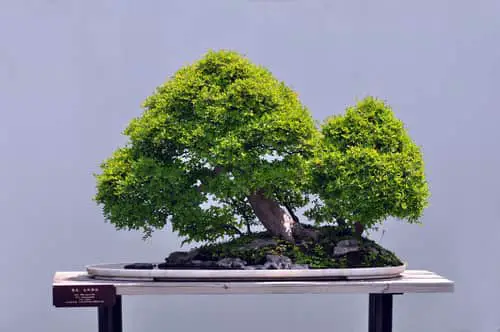
Chinese elm bonsai is the world’s most popular bonsai tree.
These trees are straightforward to grow, super hard to kill, and can be grown quickly in indoor and outdoor environments.
Ficus
Ficus bonsai trees are easily the best indoor bonsai trees to grow.
These are relatively slow-growing, meaning maintenance is easy and can last longer than other varieties without water.
Consider ginseng focus bonsai species for best results.
Maple
While outdoor bonsai trees can be challenging to grow, Maple bonsai trees are fairly straightforward.
These trees are hardy, meaning they do well in even the coldest of temperatures and will require minimal pruning.
On top of this, they provide bright-colored leaves during different parts of the year.
Fukien tea
Like Chinese elms, Fukien tea bonsai trees are super easy to care for.
These are amongst the most inexpensive bonsai trees available, meaning that if you want to get started with bonsai but need more money, this tree will be a fantastic option.
Jade
Another easy-to-care-for bonsai tree has to be the Jade tree.
These succulents make for a great indoor bonsai tree and can go up to two weeks without watering.
What makes bonsai hard to grow?
The main factors that make bonsai hard to grow are your tree’s sunlight, water, and temperature requirements. Constant pruning and care for fast-growing species, pests, and diseases in outdoor bonsai species can also be challenging.
Which common bonsai tree species are hard to take care of?
So while the above bonsai trees are the most challenging to grow, they aren’t exactly the most common ones you will see in your local garden center.
As such, if you ask me what the most challenging bonsai tree to grow is, that is also super widespread and popular, Juniper bonsai.
While these are incredibly pretty, these bonsai trees need much care and attention.
On top of this, these trees need to be kept outdoors, meaning extra care has to be taken into consideration when managing the temperature range of the tree.
Finally, the needle-like leaves mean that this tree can be challenging and unforgiving to prune.
What are the hardest bonsai tree styles to create?
Both cascade and literati styles are the hardest bonsai tree styles to replicate. These often take years of training and patience to master.
Are bigger bonsai trees harder to care for than smaller bonsai trees?
Bonsai trees that are larger and fall into the bigger size classifications are harder to care for than their smaller counterparts. This is because the larger a bonsai tree becomes, the more maintenance will be required to care for the tree.
I recommend growing a bonsai tree no larger than 40cm for best results.
Are fruit bonsai trees hard to grow?
Fruit bonsai trees can often be challenging to grow., These trees will usually be harder to grow than their non-fruiting counterparts due to the added nutrients and care the fruit will need to grow.
Lemon, Orange, and other citrus fruit bonsai trees will also need much warmer temperatures to thrive than non-fruiting trees.
Can any tree species be transformed into bonsai?
In theory, almost any tree species can be transformed into a bonsai. Bonsai is the art of miniaturizing and shaping trees in containers, and it can be applied to a wide range of tree species.
However, not all tree species are equally suitable or easy to work with for bonsai cultivation. Some tree species are more commonly used and favored for bonsai due to their specific characteristics, growth patterns, and adaptability to container cultivation.
What is the hardest bonsai tree to take care of? -Survey results
Finally, I wanted to ask 20 plant passion readers their opinion on the hardest bonsai tree to care for.
You can see the results below:
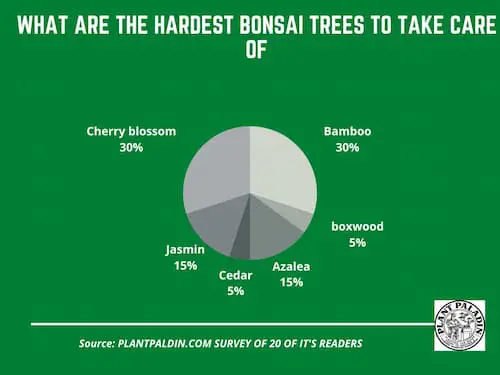
My top picks for the gear you will need!
So like I mentioned earlier, over the past three years of running PlantPaladin, hundreds of people have asked me for my recommendations on the best bonsai gear on the market.
Having spent thousands of dollars on bonsai items these past few years and tested at least 100 bonsai-specific products, I’ve listed my favorite products below – All of which I highly recommend and think you can get great value.
They can purchase directly by clicking the link to take them to Amazon.
Bonsai Tool Set: One of the significant challenges I’ve had is finding a toolset that was not only durable but didn’t break the bank. SOLIGT has recently developed a fantastic bonsai tool set that covers all the tools you need to trim, prune, and repot your trees. – You can grab it here.
Complete Bonsai Set: Many of you will want to grow your bonsai trees entirely from scratch, but finding the varicose seeds, pots, and other items in one place can be challenging. Leaves and Sole then have created a complete bonsai set that I’ve personally used that ticks all the boxes. You can grab it here.
Bonsai wire: The number of times I’ve run out of wire for my bonsai or purchased cheap bonsai wire that doesn’t do the job is embarrassing for me to admit. After a lot of trial and error, I found that using Hotop’s aluminum bonsai wire is one of the best options on the market. This can easily be used for both indoor and outdoor bonsai. You can grab it here.
